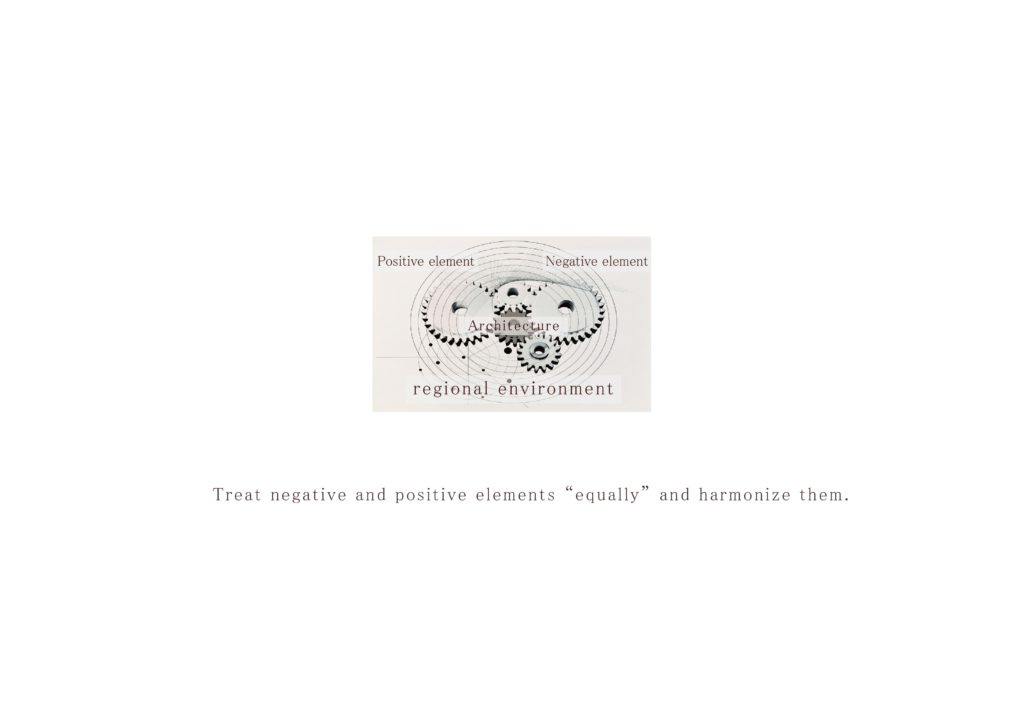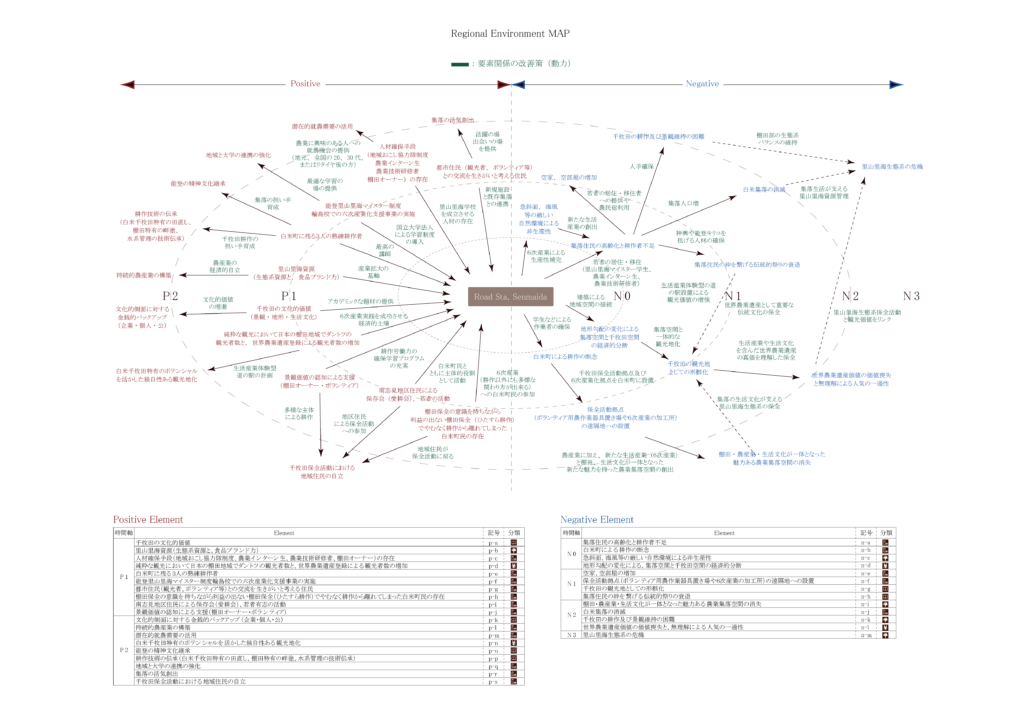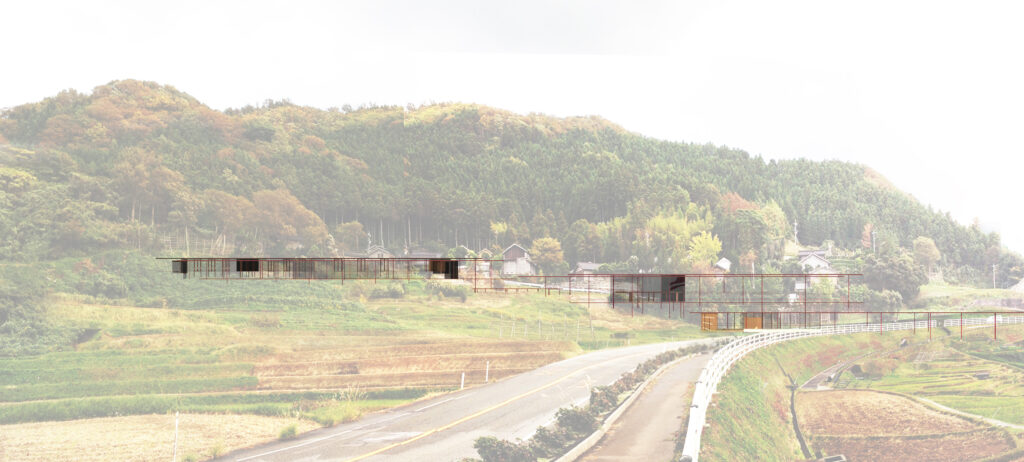




共生系の建築 – Symbioticsystem architecture –
(English Below)
2011年6月ユネスコの世界農業遺産に登録された能登の里山里海。その中でも特に人が集まる観光地である石川県輪島市白米町の「白米の千枚田」を舞台とした地域活性を目的とする複合施設です。(2012年から2013年に設計)
地域に入って町民、棚田保存の会、市役所、土木事務所、観光者、棚田オーナー制度のオーナー、等あらゆる地域関係者の方々にアプローチして具体的な状況を詳細に調査しました。
これらの人々からは当然、敷地の将来に対してポジティブな情報もネガティブな情報も出てきましたが、それを分け隔てなく収集し、できる限り全体を把握することに努めました。里山里海の生態系の成り立ち、地形や地盤、用水計画のような土木資料、集落の過去の形状やそこでの生活・文化といった歴史資料、町民や地域住民の構成やそれぞれの方の立場や気持ち、高齢化とともにどのように棚田が支えられてきたか、世界農業遺産登録とともに何が変わったか等の地域経済的な資料。敷地の文脈についても特定の分野に限定することなく全体を把握することに努めました。
こういった情報を集めきった時見えてきたのは、一見ネガティブな要素さえも数少ない資源として活用しながら、自分たちにとってより良い将来を切り開こうとする地域住民の姿でした。
都市部のように資源が次々と生まれる場所でなく、人口減少はじめ資源がどんどん枯渇する将来を抱えているため、そういった姿勢で臨まない限り活路がないために至った姿勢なのかもしれませんが、それはあるいは、里山里海とともに生きてきた生活文化にある「あるものを好循環させ続ける」生活の知恵が生んだ姿なのかもしれません。
そこにどんな建築が必要とされるか、言い換えるとその建築の形が何を目的として決定されるべきか考えた時、そこに生きる人たちを含めたそこに関わる環境のネガティブなものもポジティブなものも全てを資源としてとらえ、それらが全て生き生きとすることを目的として決定されるものでなければいけない、という設計方針に至りました。それが「共生系の建築」です
In June 2011, ”Satoyama Satoumi in Noto” was registered as a World Agricultural Heritage Site by UNESCO. This complex aims to revitalise the local area in Shiroyone-no-Senmaida rice field in Shiroyone-machi, Wajima City, Ishikawa Prefecture, which is one of the most popular tourist destinations in the area. (Designed between 2012 and 2013)
We went into the area to conduct a detailed survey of the specific situation by approaching all kinds of local stakeholders, including the town’s residents, the association for the preservation of the terraced rice paddies, the town hall, the civil engineering office, tourists, and the owners of the terraced rice paddy owner system.
Naturally, these people gave us both positive and negative information about the future of the site, but we tried to collect this information in an unbiased way and to get as complete a picture as possible. We tried to collect as much information as we could, including: information on the ecosystem of the village and the sea, topography and ground, civil engineering data such as water supply plans, historical data such as the past shape of the village and the life and culture there, information on the composition of the town and local residents, their positions and feelings, how the terraced rice paddies have been supported by the ageing population, and what has changed with the registration of the village as a World Agricultural Heritage site. We did not limit ourselves to any particular area of investigation, but tried to get as comprehensive a picture of the site as possible.
When we had gathered all this information, what we saw was a local population that was trying to create a better future for itself, using even the seemingly negative elements as one of its few resources.
Perhaps it is because we are not a place where resources are constantly being produced, as in urban areas, but because we are facing a future where the population is declining and resources are being depleted.
But perhaps it is also the result of the wisdom of a lifestyle that has lived with the Satoyama and the Sea, a lifestyle that keeps things in a virtuous cycle.
When we think about what kind of architecture is needed there, or in other words, what the purpose of the form of the architecture should be, we should consider all the negative and positive aspects of the environment, including the people who live there, as resources, and determine them with the purpose of making them all come alive. We have come to the conclusion that the architecture must be “symbiotic”. This is the Symbioticsystem architecture.
